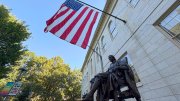During the past several days, the Trump administration has renewed its pressure campaign against Harvard, opening up fresh avenues of attack.
On September 19—the same day that $46 million in government grants began flowing back to University researchers, as mandated by a court ruling from a U.S. district judge—the Trump administration tightened its financial scrutiny of Harvard and added new restrictions on the University’s ability to access federal funds. Citing “growing concerns” about the University’s financial stability, the government placed Harvard on heightened cash monitoring status. The designation requires that Harvard use its own funds to pay out federal aid to students before requesting reimbursement from the U.S. Department of Education (DOE); under normal circumstances, that aid money is disbursed to universities in advance by the government, not reimbursed later.
In addition, the DOE said it was requiring Harvard to provide a $36 million letter of credit, guaranteeing that it would fulfill its financial obligations to students and the government. (The New York Times reported that this amount is about 30 percent of the total federal student aid that Harvard has received during the past year. Overall, the large majority of Harvard’s financial aid funding is covered by the University itself, rather than by the federal government.)
In a letter to President Alan M. Garber, the DOE said that the heightened cash monitoring status was triggered by several factors, including recent layoffs and hiring and salary freezes at Harvard. The government also cited as a concern Harvard’s issuance of $1.2 billion in bonds earlier this year—money that was borrowed partly in response to government threats to slash billions in federal research funding. (As education news outlet Higher Ed Dive put it, the DOE “cited the Trump administration’s own actions against Harvard as driving forces destabilizing the university’s ability to meet its obligations.”)
Another trigger, the government said, was a federal task force’s determination in June that Harvard had violated Title VI of the Civil Rights Act through indifference or “willful” participation in antisemitism on campus—an allegation that University spokesperson Jason Newton forcefully refuted at the time. Title VI violations also threaten federal funding.
In a separate letter to Harvard, also dated September 19, the DOE threatened to cut off all access to federal student aid over what it said was the University’s “continued refusal” to turn over admissions data. The letter gave Harvard 20 days to comply. In May, the Trump administration opened an investigation, alleging that Harvard uses race-based considerations in its admissions policies, a practice that the Supreme Court banned in a 2023 ruling. Although the DOE’s letter this month did not specify exactly what admissions documentation it is seeking from Harvard, in previous settlements with the government, other universities have agreed to turn over applicants’ grades and test scores and information about their racial backgrounds. This is not data universities typically share with the government.
A Harvard spokesperson did not respond to requests for comment on these latest government demands. Previously, University officials have characterized the Trump administration’s actions against Harvard as illegal retaliation and a violation of Harvard’s First Amendment rights.
One other recent move by the government was not aimed specifically at Harvard but could potentially cost the institution millions. Last Friday, Trump signed a proclamation that would impose a $100,000 fee on every new H-1B visa petition. The visa allows foreign workers in specialized occupations to stay in the country temporarily and is a major mechanism for hiring international scholars and researchers. The Crimson reported this week that between 2017 and 2024, Harvard sponsored an average of 125 new H-1B visa petitions each year, which would add up to more than $10 million in annual fees.
Meanwhile, amid these various developments ratcheting up the financial pressure on the University, the long-anticipated settlement negotiations between Harvard and the Trump administration have reportedly stalled. At least for now.









